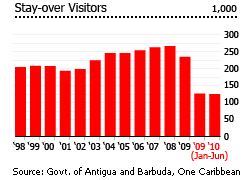Antigua and Barbuda ready to bounce back
2010 was not a good year for Antigua and Barbuda. After enjoying a property and tourism boom in recent years, the twin-island nation was affected by the global financial crisis in 2008 and has yet to recover. Tourists stayed away – and since the nation’s economy is largely driven by tourism, real GDP went down and construction and foreign direct investment declined.
A luxury retreat in the Caribbean
Antigua and Barbuda is known internationally as a luxury holiday and wedding destination, renowned for its tropical climate and its 365 beaches – one for every day of the year. With its gorgeous views, verdant landscape and relatively good property values, it has become an ideal location for a second home abd attracts celebrities like Oprah Winfrey, Giorgio Armani, Richard Branson and Eric Clapton. It is also now being promoted as a family-oriented vacation spot.
Economy down

In 2010, the GDP declined by 4.1% – after having already fallen by 7% in 2009. The tourism and construction boom lasted from 2003 to 2007; in that period, the GDP grew an average of 6% a year and reached over 12% in 2006, when the nation was preparing to host the Cricket World Cup.
Even remittances from overseas Antiguans and Barbudans were down last year. Worse, the government’s large debt burden limited its capacity to effectively address the crisis.
House prices little changed
There are no official records of house prices in Antigua and Barbuda, and reliable information on the property market is hard to come by. According to a recent report by Global Property Guide, a two-bedroom house in Antigua costs about $346,301 while a three-bedroom house costs $589,250. The rental yield per annum for a two-bedroom house is around 3.75%, and 4.13% for a three-bedroom house.
Attractive and exclusive residential developments on the islands include:
- Jolly Harbour – a 350-acre complex consisting of a marina, commercial centre, and a golf club. At its heart lies Harbour Island, offering building plots;
- Jumby Bay – a 300-acre luxury private resort offering individually priced homes and estates;
- Marina Residences – a development consisting of three buildings on the waterfront, with units ranging from US$450,000 to US1.1 million; and
- NonSuch Bay – with three-bedroom beachfront apartments ranging from US$475,000 to US$995,000 and exclusive townhouses priced from US$950,000 to US$1,150,000.
During the boom years, house prices in Jumby Bay increased 60% to 100%, according to the Global Property Guide. However, the market has been cooling since 2008.
Construction hits rock bottom
The construction industry was hard hit in 2009 (declining by 10%) and in 2010 (falling a further 5%).
The number of approved construction plans has dropped in the last three years, according to the Antigua and Barbuda Development Control Authority. The fall was sharper for commercial properties than for residential properties.- In 2008, there were 619 approved plans for new commercial and residential properties, with combined estimated value of $603,722,425.
- In 2009, the number of approved plans fell to 360 – valued at an estimated $457,710,980.
- From January to October 2010, only 217 plans were approved by the DCA, with combined estimated value of $200,668,770 for both commercial and residential properties.
Crime in paradise

Since 2008, there has been an increase in violent crime and in the overall crime rate. A major cruise line removed Antigua from its itinerary in early 2010 when one of its passengers was murdered on a secluded beach. The Foreign and Commonwealth Office of the UK government also reported a shooting incident in 2008 which killed two foreigners and another in 2009 which killed one foreigner.
2011: Antigua and Barbuda’s year for tourism
In 2011 Antigua and Barbuda is celebrating the 30th anniversary of independence, and holding a month-long Homecoming Campaign from October 15 to November 15, to entice Antiguans and Barbudans living or working abroad to come home and boost tourism numbers. Antigua and Barbuda is among the most tourism-dependent countries in the Caribbean. The industry accounts for more than 70% of GDP and over 80% of employment.
Through promotions and improved tourism-related infrastructure, the government targets one million visitors to come to the islands in 2011.
New Year, new infrastructure
In June 2010 the country received a $117.8-million loan from the IMF, which predicts economic growth of 3.1% for 2011, given reforms in tax policy, public sector efficiency, and public finance management.
Antigua and Barbuda’s infrastructure has been benefiting from large loans from other countries. In late 2009 a loan from the Venezuela government was used in part for the improvement of the Barbuda airstrip. A road construction was also funded by the Japanese government.
This year, a new airport terminal will be built, thanks to a US$45-million-dollar loan from the People’s Republic of China.
Other projects in development includes a €6-million expansion of the Antigua and Barbuda Hospitality Training Institute.
Buying property in Antigua and Barbudas
Foreign buyers are required to apply for an Alien’s Land Holding License, which usually takes up to four months to be approved. The license cost is about 5% of the value of the property being purchased. Buyers are required to pay 2.5% stamp duty on property transfers.
As the the country is small and mountainous, development is restricted and there is limited number of properties available for purchase. Most properties available are freehold. Land can be bought or leased from the government, which owns 55% of land in Antigua, or the private market. Land ownership in Barbuda is prohibited.